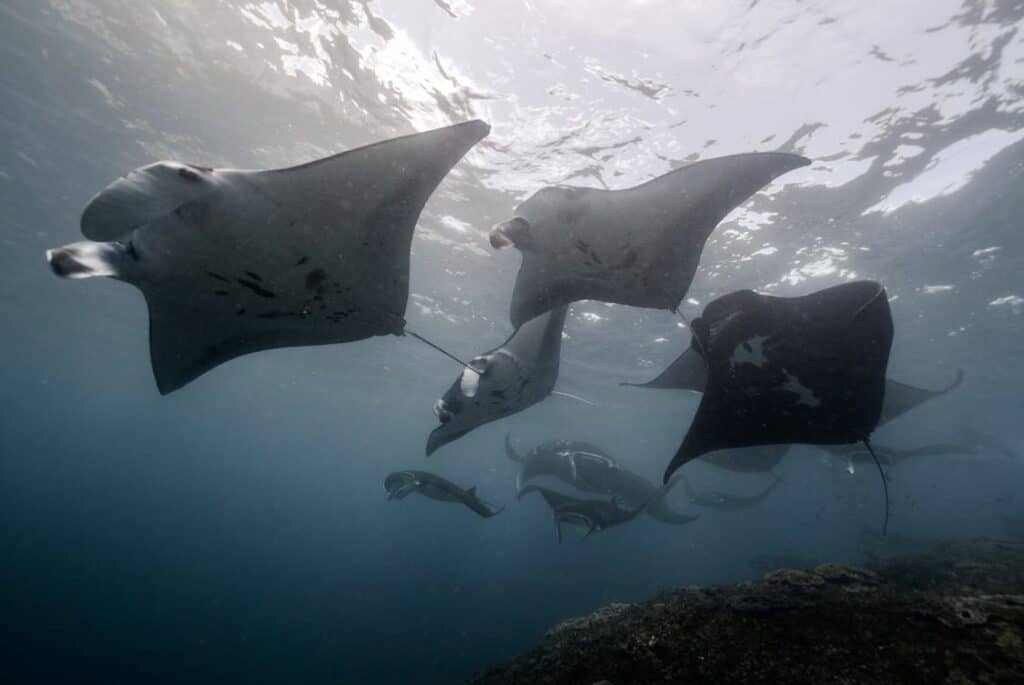Going on your first manta ray snorkeling trip can stir a mix of excitement and healthy nerves. A little preparation helps you feel more at ease in the water and makes the encounter smoother for both you and the animals.
The tips below focus on physical readiness, sensible gear choices, etiquette, and timing so you can enjoy the spectacle without fuss. With calm breathing and steady habits you will be better placed to soak up the moment when the rays arrive.
Preparing Physically
Build basic stamina in the weeks before the outing by swimming or doing light cardio and breath control work that mirrors snorkel rhythms. A few sessions with fins on will strengthen legs and ankles so they do not tire quickly while you float and watch the sea.
Practice slow breathing through a snorkel in calm water to lower panic and to keep carbon dioxide from building up when mantas glide close. Bear in mind that a relaxed body uses less oxygen and that fitness for snorkeling is more about steady stamina than raw power.
Choosing The Right Tour
Pick a small group operator with experienced guides who follow local wildlife rules and who can read currents and animal behavior. Look for reviews that speak to guide conduct and boat safety and ask about maximum participant numbers so that the animals are not overwhelmed.
For those planning ahead, checking manta ray night snorkel kona.com can help you compare options and secure a reputable tour online.
Confirm lighting protocols for night feeds and learn whether the crew enforces strict no touch policies to protect both guests and rays. Match trip length to your tolerance for time on the water and pick departure times that align with when you are calm and rested.
What To Pack For The Water
Bring a well fitting mask with a soft skirt and a snorkel you can clear easily because an uncomfortable seal will steal attention from the show. A snug pair of fins that do not chafe helps you move with the current rather than thrashing, and a short rash vest gives sun protection and mild buoyancy without overheating.
Leave jewelry and loose items ashore as they can tangle or frighten marine life, and bring a lightweight UPF top if the outing runs in daylight. A small waterproof pouch for keys and for a phone keeps essentials dry and avoids awkward transfers on board.
Gear And Fit Tips
Try your mask and fins in a pool first so you spot leaks and fit problems before open water poses time pressure. Adjust snorkel mouthpieces and fit mask straps in a way that is comfortable behind the head rather than too high on the crown.
If you rent a wetsuit make sure it fits snugly but not so tight that circulation is affected and practice getting in and out until zippers and seals feel familiar. Good fit reduces fatigue and keeps focus on the rays rather than on mid observation tweaks.
Safety And Manners Around Manta Rays

Follow the guide and keep a calm, horizontal posture in the water to avoid casting shadows on feeding mantas or bumping into them while they sweep their wings. Do not chase or attempt to touch rays because contact can stress animals and raise health risks for both parties.
Keep clear of their path and let them approach if they choose, using slow, deliberate movements that show you are not a threat. If a ray glides near, avoid blocking its route and move gently aside so the animal can continue its routine without sudden interruptions.
Managing Motion Sickness And Anxiety
If boats unsettle you choose a seat near the center where motion is least pronounced and time light meals so your stomach is neither empty nor overloaded. Try ginger or a mild over the counter remedy if those have helped before and always test medication prior to the trip to see how your body reacts on the water.
Breathing exercises and brief sightlines toward the horizon calm nerves and break the cycle of escalating worry. Share concerns with the crew and ask for a gentler pace if you feel rushed; most operators will adjust to keep guests comfortable.
Photography And Respectful Viewing
Decide ahead whether photography is for you and learn your camera or phone controls so you spend less time fumbling and more time observing manta behavior. Turn off flash and avoid bright continuous light that can disorient feeding rays and that spoils the experience for others nearby.
Frame images with wide angles rather than closing in and approach slowly so the animal does not feel cornered by lenses. Obey no photo zones and heed the guide when they ask to put cameras away to prioritize animal welfare over images.
Timing And Local Conditions
Check tide charts and moon schedules with the operator because many manta encounters link to plankton blooms that shift with current and night light levels. Wind and swell can change a calm surface into a bumpy ride, so having a spare day in your plan reduces pressure to make a single outing work.
If the trip includes a night feed, learn what to wear for cooler air and water temperatures and confirm the lighting protocol used by the crew. Be ready for plans to change with weather or animal activity and treat adjustments as part of the natural rhythm rather than a setback.

